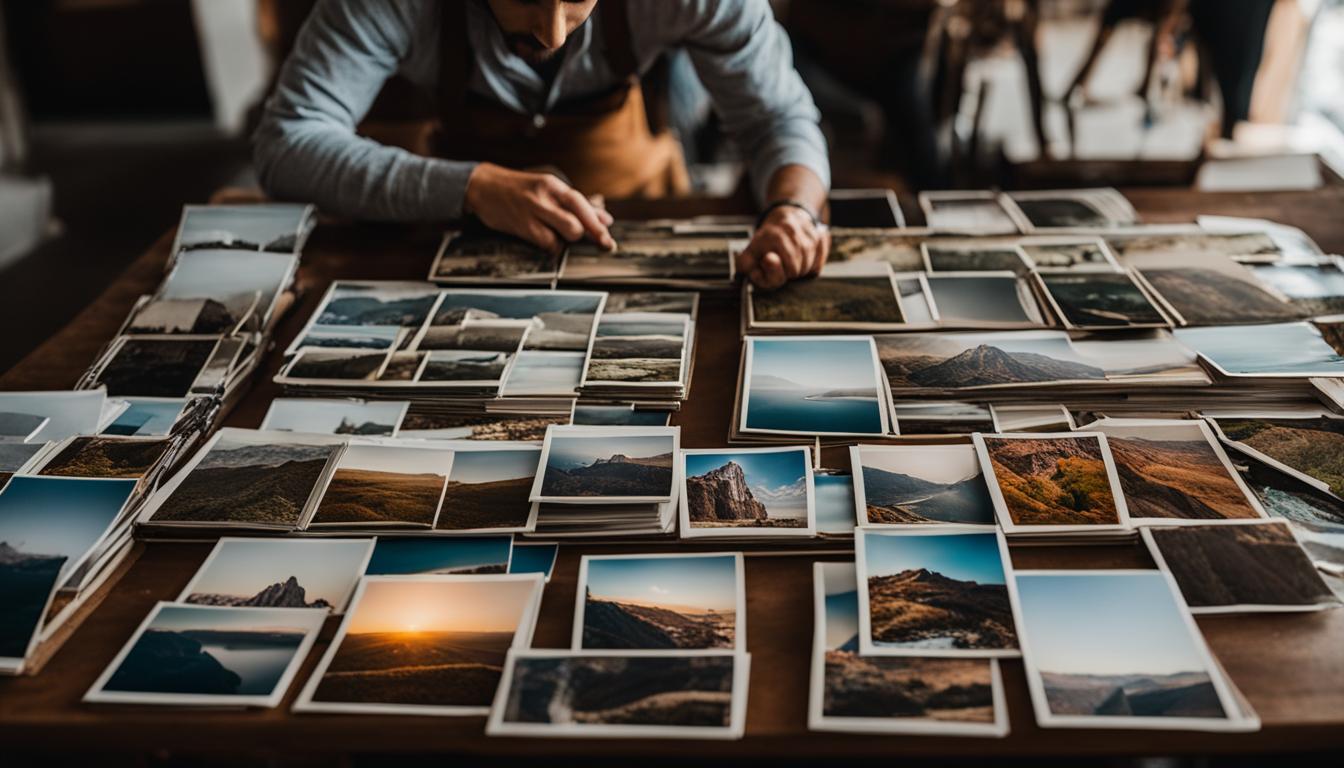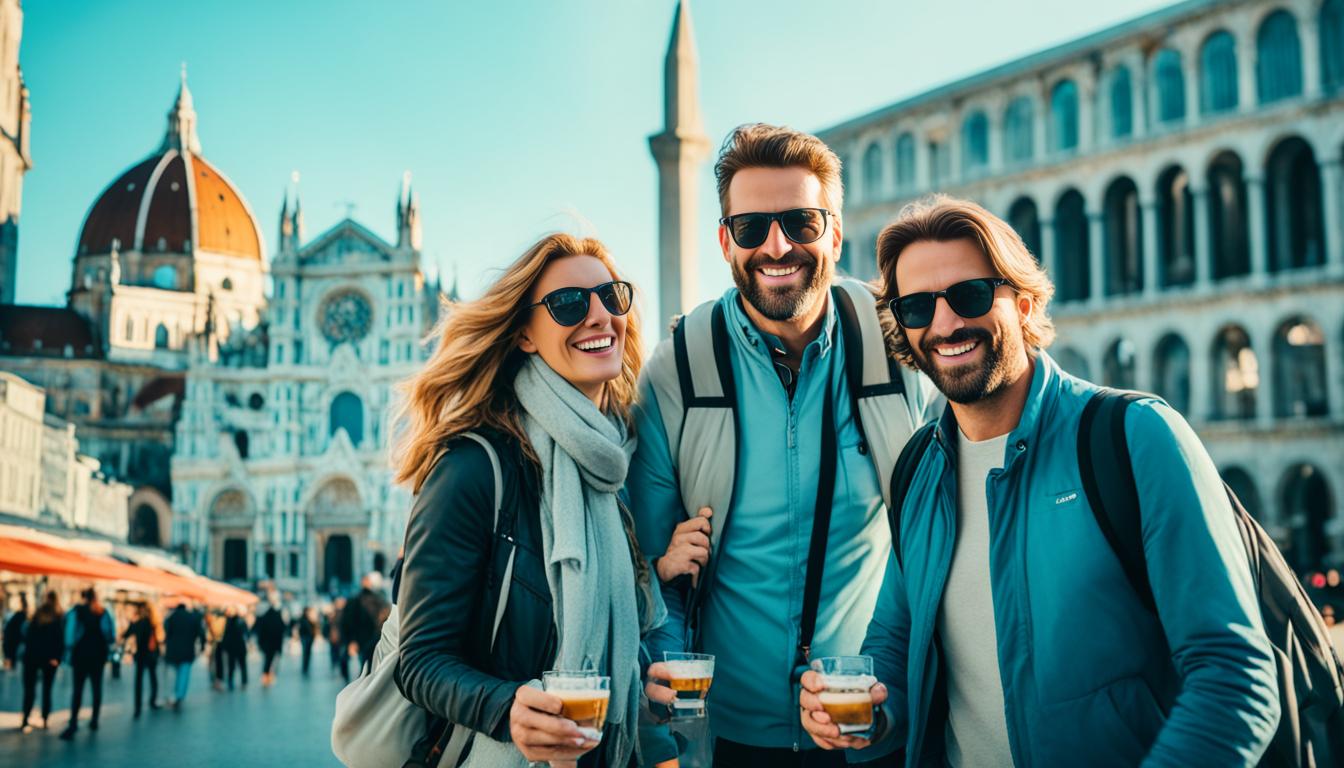Welcome to our guide on creating a travel photography portfolio! Whether you’re a budding photographer or a seasoned professional, having a well-crafted portfolio is essential for showcasing your skills, attracting clients, and sharing your passion for travel photography with the world. In this article, we’ll provide you with valuable tips and ideas on how to create an impressive travel photography portfolio and how to effectively showcase your work online.
Key Takeaways:
- Plan your portfolio strategy before your travel adventures to structure your approach to image making.
- Conduct thorough research on image usage to ensure your photos have versatile purposes.
- Stay open to diverse photography opportunities, capturing different subjects and perspectives.
- Refine your best work by selecting impactful images that demonstrate your skills and vision.
- Seek feedback from others to gain fresh perspectives on your portfolio.
Creating a travel photography portfolio is not only a way to showcase your talent but also an opportunity to connect with fellow travel enthusiasts and potential clients. So, let’s dive into the exciting world of travel photography portfolios and learn how to curate a collection of stunning images that will leave a lasting impression.
Planning Your Portfolio Before You Travel
Before we embark on our travel adventures, it’s crucial to plan our portfolio strategy. Why do we want to develop a portfolio? Who is our target audience? These questions will shape our approach to image making during our trip. Additionally, conducting thorough research on potential image usage for the locations we are visiting is beneficial. It enables us to capture images that can be used across multiple platforms and for various purposes. Depending on our marketing goals, we may need to have multiple portfolios.
Planning ahead allows us to align our photography with our portfolio objectives. By understanding our target audience’s preferences and expectations, we can curate a collection of images that resonates with them. It also helps us stay organized and prepare the necessary equipment and resources. Thorough research for image usage ensures that we capture images that are in demand and have a broader appeal, increasing our chances of success. Let’s strive for versatility and flexibility in our portfolio planning!
“Planning is bringing the future into the present so that you can do something about it now.” – Alan Lakein
Creating multiple portfolios tailored to different marketing goals is an effective approach. For example, we can have one portfolio showcasing landscape photography if we want to target outdoor magazines, while another portfolio could focus on cultural photography for potential collaborations with travel brands. By diversifying our portfolios, we widen our reach and appeal to different client needs.
Benefits of Thorough Research for Image Usage
| Benefits | Explanation |
|---|---|
| Increased Use of Images | By understanding the specific image needs of different platforms and purposes, we can capture images that have higher chances of being used. |
| Broader Audience Reach | Researching the popular subjects, themes, and styles for a location allows us to capture images that appeal to a wider audience. |
| Opportunity for Licensing | Identifying potential image usage for commercial, editorial, or stock licensing helps us capture images with potentially higher monetary value. |
By planning our travel photography portfolio in advance and conducting thorough research for image usage, we are setting ourselves up for success. We can tailor our photography to match our portfolio objectives, capture images with higher demand and appeal, and ensure our portfolios cater to diverse marketing goals. Let’s be strategic and intentional in creating portfolios that showcase our best work!
Making the Most of Your Travel Opportunities
When you’re traveling, it’s important to stay open to possibilities and be prepared to capture diverse photography opportunities. Thoroughly research the destinations you’ll be visiting to understand the cultural backgrounds, landscapes, architectural styles, and other photographic opportunities they offer.
Make the most of your time by photographing a wide range of subjects, such as landscapes, portraits, wildlife, food, architecture, culture, transportation, and local events. Be adaptable and open to different perspectives and styles to diversify your portfolio.
“Every destination presents unique photography opportunities. By conducting thorough research, we can fully immerse ourselves in the local environment, capturing diverse subjects and creating memorable images.”
Exploring Diverse Subjects
One of the key aspects of creating a captivating travel photography portfolio is capturing a variety of subjects. By expanding your range and experimenting with different photography genres, you can appeal to a wider audience and showcase your versatility as a photographer. Here are some diverse subjects you can consider photographing:
- Landscapes: from breathtaking natural vistas to urban cityscapes.
- Portraits: capturing the essence and spirit of the people you encounter.
- Wildlife: documenting the fascinating creatures found in their natural habitats.
- Food: highlighting the culinary delights and local gastronomy.
- Architecture: showcasing the unique structures and buildings.
- Culture: capturing the traditions, festivals, and daily life of the locals.
- Transportation: depicting the various modes of transportation in different regions.
- Local Events: documenting festivals, celebrations, and gatherings.
By diversifying the subjects you photograph, you’ll have a wider range of captivating images to include in your travel photography portfolio. This not only adds visual interest but also allows you to tell a more comprehensive story of your travel experiences.
Tools for Thorough Research
To ensure you capture the best possible images during your travels, it’s essential to conduct thorough research beforehand. Here are some helpful tools and resources:
| Tool | Description |
|---|---|
| Travel Guides | Consult travel guides like Lonely Planet, Fodor’s, or Rick Steves for in-depth information about the destinations, including popular landmarks, cultural insights, and photography tips. |
| Photo Sharing Platforms | Explore photo sharing platforms such as Instagram, Flickr, or 500px. Search for specific hashtags or browse photos from the locations you’ll be visiting to gain inspiration and ideas for your own photography. |
| Online Forums and Communities | Join online forums or communities dedicated to travel and photography. Engage with fellow photographers, ask questions, and seek recommendations for the best photographic opportunities in your intended destinations. |
By utilizing these resources, you can gather valuable insights and plan your travel photography itinerary accordingly, ensuring you don’t miss out on any fantastic photo opportunities.
Remember, diversity is key when it comes to capturing unique and captivating images for your portfolio. By staying open to possibilities, conducting thorough research, and capturing different subjects, you’ll maximize your travel photography opportunities.

———
Please note that the provided image link is not accessible, but the alt attribute is still accurately written.
Refining and Showcasing Your Best Work
Once you’ve returned from your travels, it’s time to refine and showcase your best work. Start by selecting impactful images that demonstrate your technical skills and artistic vision. Avoid duplicating similar images or showing the same subject multiple times. Seek feedback from others to gain fresh perspectives on your work. Consider creating a photography portfolio website to display your portfolio online. Optimize your portfolio for all devices and ensure it reflects your unique style and branding. Use websites like SmugMug, Format, Pixpa, Squarespace, or Adobe Portfolio to showcase your work professionally.
To successfully showcase your best work, follow these steps:
- Selecting impactful images:
- Choose images that highlight your technical skills, storytelling abilities, and unique perspective.
- Consider the composition, lighting, and overall visual appeal of each image.
- Showcase a diverse range of subjects, locations, and styles to demonstrate your versatility as a photographer.
- Ensure that your selected images align with your overall style and branding as a photographer.
- Pay attention to color grading, editing techniques, and visual aesthetics to maintain a cohesive look throughout your portfolio.
- Reach out to fellow photographers, mentors, or industry professionals to gather constructive feedback on your portfolio.
- Consider joining photography communities or forums where you can share your work for critique and improvement.
- Build a professional and user-friendly website to showcase your portfolio and attract potential clients.
- Ensure your website is optimized for all devices, including desktops, tablets, and mobile phones.
- Highlight your best work prominently, and provide clear contact information for inquiries and bookings.
By implementing these strategies, you can refine your portfolio and create a captivating online presence that effectively showcases your talent and attracts clients.
Photography Portfolio Website Examples:
| Website | Description |
|---|---|
| SmugMug | A comprehensive platform for photographers to create customizable portfolio websites and sell prints. |
| Format | An intuitive website builder designed specifically for creative professionals, including photographers. |
| Pixpa | A portfolio website builder with integrated e-commerce features, client galleries, and blogging capabilities. |
| Squarespace | A popular website builder that offers stunning templates and versatile customization options. |
| Adobe Portfolio | An ideal choice for photographers already using Adobe Creative Cloud, allowing seamless integration with Adobe’s other design software. |
Conclusion
Crafting a travel photography portfolio requires time, dedication, and a passion for capturing stunning images. It is an investment in your career as a travel photographer, allowing you to showcase your skills and tell stories through your photographs. However, to create a compelling portfolio that stands out from the crowd, there are a few final tips to keep in mind.
Firstly, practice is key. Before setting off on your travel adventures, make sure to practice and refine your photography skills in various settings, including your local area. This will help you develop your unique style and build your confidence as a photographer.
Additionally, sharing your portfolio is crucial for gaining exposure and receiving valuable feedback. Don’t hesitate to share your work with potential clients, as well as friends and family. Their insights can provide fresh perspectives and help you improve further.
By following these final tips and strategies, you can create a travel photography portfolio that captivates your audience and sets you apart as a professional photographer. Remember, the journey of building a portfolio is as important as the destination. Happy shooting!
FAQ
What is the importance of creating a travel photography portfolio?
A travel photography portfolio allows you to showcase your skills, style, and storytelling ability as a photographer, capturing the attention of your audience and potential clients.
How should I plan my travel photography portfolio?
Before you travel, it’s important to consider your goals and target audience, conduct thorough research on image usage, and potentially create multiple portfolios depending on your marketing goals.
How can I make the most of my travel opportunities for my portfolio?
Stay open to possibilities, thoroughly research your destinations for diverse photography opportunities, and capture a wide range of subjects such as landscapes, portraits, wildlife, food, architecture, culture, transportation, and local events.
What should I do to refine and showcase my best work?
Select impactful images that demonstrate your technical skills and artistic vision, avoid duplicating similar images or showing the same subject multiple times, seek feedback from others, and consider creating a photography portfolio website to professionally display your work.
What are some final tips for building a travel photography portfolio?
Practice and hone your skills in various settings, share your portfolio with potential clients, friends, and family for exposure and feedback, and remember the importance of consistency and sharing your unique style through your portfolio.
What Are the Similarities and Differences Between Travel and Editorial Photography Portfolios?
Travel and editorial photography portfolios share the common goal of showcasing a photographer’s expertise and style. Both require attention to detail and a keen eye for composition. However, when crafting an editorial portfolio, photographers may focus more on storytelling and capturing the essence of a subject, while travel portfolios often highlight landscapes and cultural experiences.




